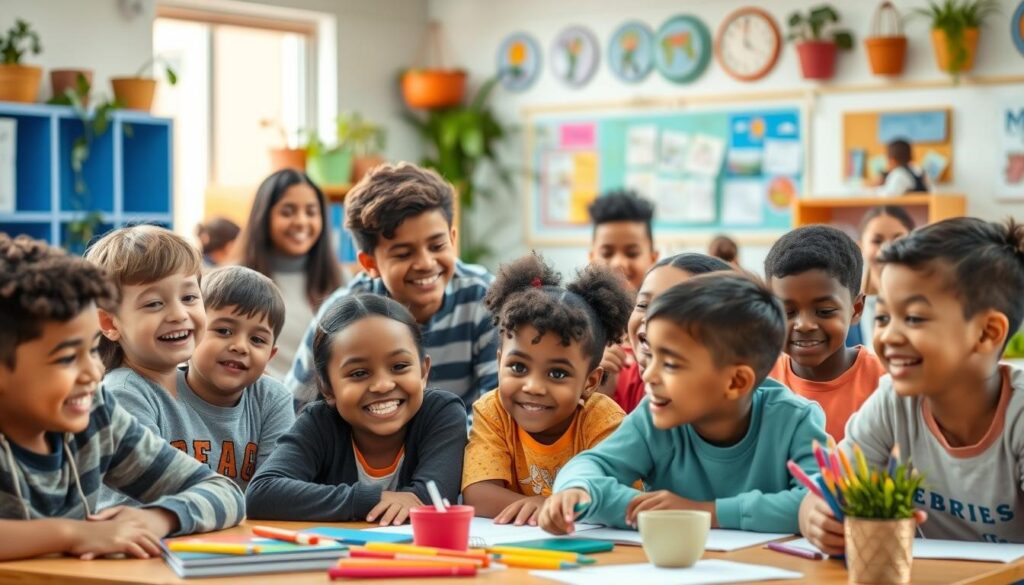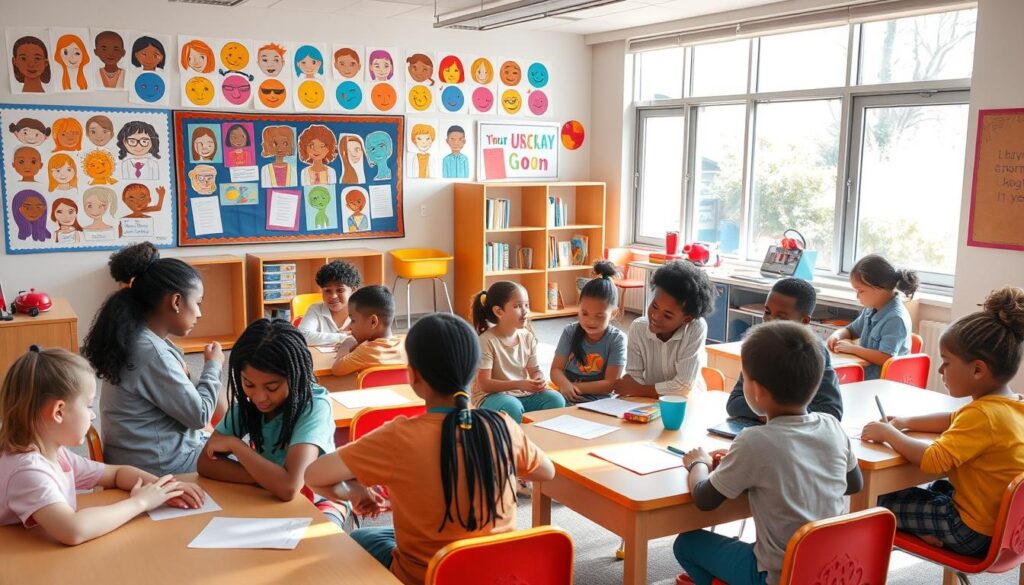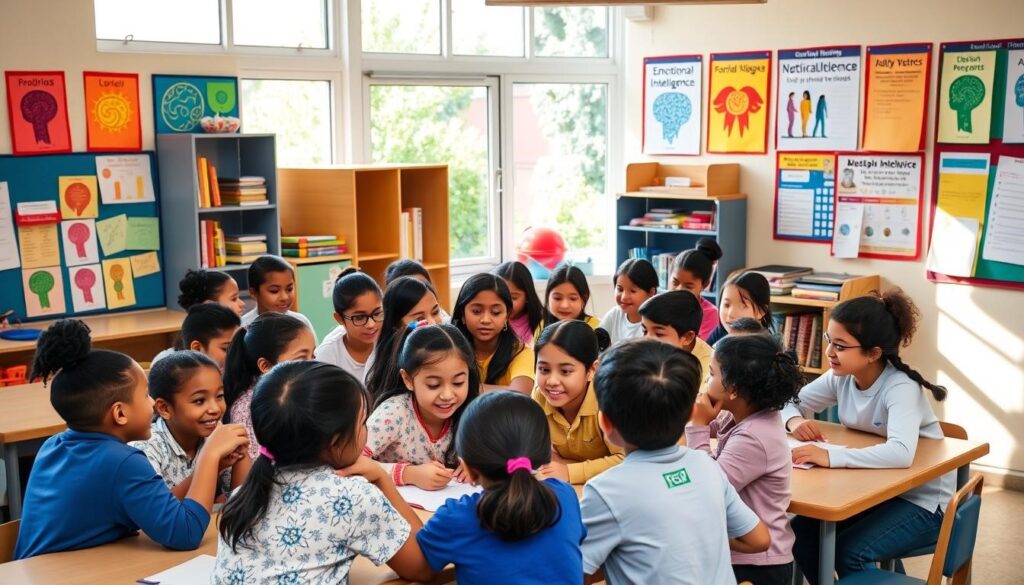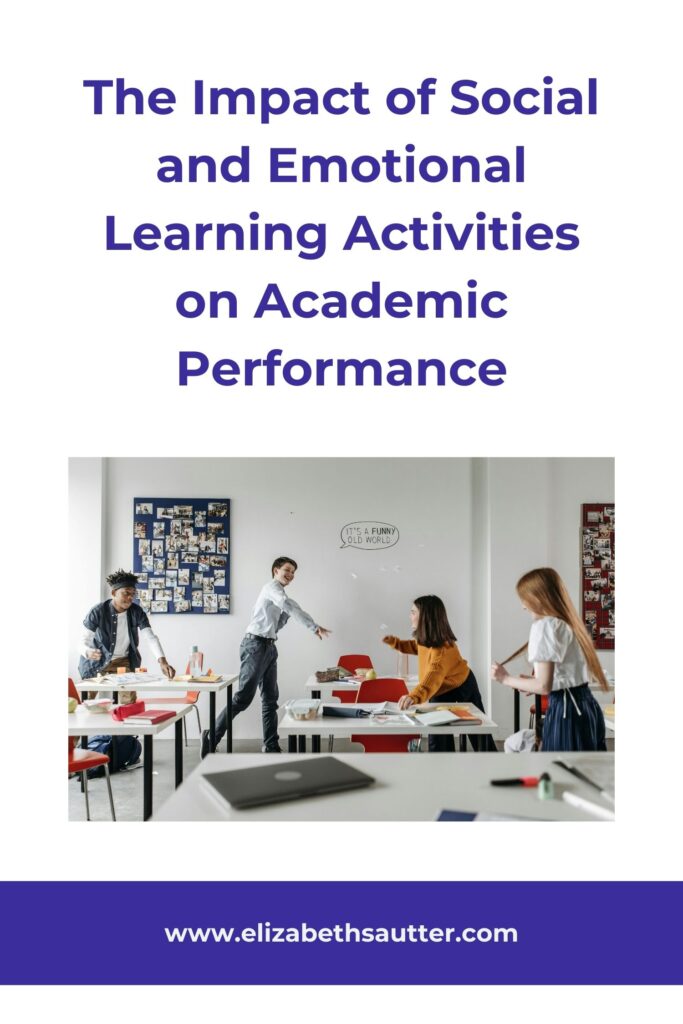Did you know that students who take part in social and emotional learning (SEL) programs see a big boost in their grades? They can gain up to an 11-percentile-point in their academic scores. This shows how important it is to teach life skills that go beyond just books and tests.
By teaching children to understand their emotions, navigate social situations and meet their goals, SEL helps them reach their full potential. It prepares them for success not just in school, but in life too.

Key Takeaways
- Research shows that social and emotional learning (SEL) can boost academic performance, leading to up to an 11-percentile-point increase in student achievement.
- SEL develops essential life skills, including self-awareness, self-management, social awareness, relationship skills, and responsible decision-making.
- Integrating SEL into classrooms, homes, and communities fosters a positive environment that promotes students’ overall well-being and personal growth.
- Educators and caregivers play a vital role in applying SEL strategies and creating a supportive atmosphere for emotional and social development.
- The impact of SEL on academic performance is measured through both data and personal experiences, providing insights for ongoing improvements.
Understanding social and emotional learning activities
Social and Emotional Learning (SEL): Building Life Skills for All Kids
Social and Emotional Learning (SEL) gives students practical skills they can use every day. It teaches them how to understand and manage their emotions, build strong relationships, and make thoughtful choices. At the heart of SEL is emotional intelligence—the ability to tune into one’s own feelings and those of others, which is essential for personal growth and connection.
What is Social and Emotional Learning?
SEL is a framework for helping kids and teens develop five essential skills:
- Self-awareness: Understanding one’s own emotions, strengths, and areas for growth.
- Self-regulation: Managing emotions and reactions in a healthy way.
- Social awareness: Understanding and appreciating the perspectives and feelings of others.
- Relationship skills: Building and maintaining positive, meaningful connections.
- Responsible decision-making: Making choices that consider personal and social well-being.
-
These skills help students navigate life’s challenges, boosting both their well-being and success in school. SEL creates a foundation that benefits every child, honoring their unique abilities and experiences.
The Importance of Emotional Intelligence
Emotional intelligence is a big part of SEL. It greatly affects how well students do in school and their social development. Students with high emotional intelligence are more confident, resilient, and empathetic. This leads to better grades and positive/meaningful social interactions.
Fostering a Positive Learning Environment
Creating a positive and inclusive learning environment is key for social and emotional learning (SEL). When students feel safe and respected, they learn better. This helps them succeed in school and life.
Strong student-teacher relationships are at the heart of a positive classroom. Teachers who connect with students build trust and belonging. They teach empathy and communication, helping students grow.
Working together is important in an inclusive learning environment. Students learn to cooperate and solve problems when they work as a team. This makes the classroom a positive place where everyone feels valued.
where everyone feels valued.
“The most powerful strategy for improving student achievement is not by focusing directly on learning and instruction, but rather by creating the conditions, the climate and culture of the school, that promote good teaching and learning.”
– Roland Barth, Educational Researcher
Creating a positive classroom climate means teaching empathy and understanding. Teachers help students see and value different backgrounds and experiences. This makes everyone feel included and valued.
Ultimately, a supportive and inclusive learning environment is crucial for SEL. By focusing on relationships, teamwork, and empathy, teachers help students build skills that will benefit them throughout their lives.
Enhancing Self-Awareness and Self-Management
Helping kids thrive in school and life means supporting their growth in self-awareness and self-management. These skills are essential for handling challenges, managing emotions, and staying motivated, even when things get tough. By developing these abilities, children are better able to navigate both the classroom and everyday situations, setting them up for success and well-being.
Strategies for Building Self-Confidence
Encouraging kids to build self-confidence is essential for developing self-management skills. By helping them set small, achievable goals, celebrating little wins, and believing in their ability to improve, they start to see their progress and feel proud of what they’ve accomplished. With this positive mindset, they learn to handle challenges and reach for their goals..
Developing Emotional Regulation Skills
Understanding and managing emotions—called emotional regulation—is also a big part of doing well in school and life. Emotional regulation helps kids handle the ups and downs of daily life, whether it’s managing frustration with schoolwork or staying calm during tests.
Simple tools like mindfulness, deep breathing, and talking about their feelings can make a difference. These techniques help kids stay steady, focused, and ready to learn, giving them a stronger foundation to tackle challenges and make the most of their school experience.
|
Skill |
Description |
Benefits |
|
Self-awareness |
The ability to understand one’s own emotions, strengths, and weaknesses. |
Helps children identify areas for growth and develop effective strategies for improvement. |
|
Self-management |
The capacity to regulate one’s emotions, thoughts, and behaviors to achieve goals. |
Enables children to stay focused, motivated, and resilient in the face of challenges. |
|
Emotional regulation |
The skill of recognizing and managing one’s own emotions effectively. |
Supports children in maintaining emotional balance and responding constructively to academic demands. |
By building self-awareness, self-management, and emotional regulation at home, kids can develop the skills they need to thrive and grow, both in school and in their everyday lives. These skills help them reach their full potential and handle challenges with confidence.
Social and Emotional Learning Activities
Teaching social and emotional learning activities both at home and in the classroom helps kids develop into well-rounded individuals. SEL activities teach essential skills like problem-solving, effective communication, teamwork, and empathy. These hands-on experiences not only support better grades but also prepare kids for life’s challenges.
One great classroom activity for building these skills is role-playing. By stepping into different roles and situations, kids practice social interactions, managing emotions, and seeing things from others’ perspectives. Role-playing gives kids a chance to “step into someone else’s shoes,” building empathy and emotional awareness in a fun, engaging way.
- Group discussions let students talk, share, and learn from each other’s views.
- Self-reflection, like journaling or mindfulness, helps students know themselves better and manage their feelings.
- Working on projects together teaches teamwork, talking, and solving problems, as students aim for a shared goal.
- Morning meetings can be a great time to check-in and share feelings.
By mixing different SEL activities into the day, it can make learning fun and powerful. These experiential learning moments not only improve grades but also prepare students for life’s challenges.
“Integrating social and emotional learning activities into the classroom is not just about improving test scores; it’s about cultivating the skills and mindsets that will help students succeed in all aspects of their lives.”

Improving Social Awareness and Relationship Skills
Learning to be socially aware and having meaningful relationship skills is another part of belonging and well-being.. These skills help build perspective taking, boost empathy and communication skills.
Promoting Empathy and Perspective-Taking
Understanding and connecting with others is at the heart of social awareness. When students practice empathy, they learn to see things from their classmates’ perspectives, which helps them respond with kindness and respect. Perspective-taking is another aspect, allowing Children to consider all sides of a situation and work toward finding common ground.
- Engage in role-playing exercises to practice empathy and perspective-taking
- Encourage students to share personal experiences and listen actively to their peers
- Use literature, films, and current events to facilitate discussions on diverse viewpoints
These methods not only boost social awareness but also improve interpersonal communication and relationship skills. These skills are vital for making and keeping meaningful friendships and solving problems.
|
Skill |
Description |
Benefits |
|
Empathy |
The ability to understand and share the feelings of another person |
Improved emotional intelligence, stronger relationships, and enhanced conflict resolution |
|
Perspective-Taking |
The capacity to consider a situation from another person’s point of view |
Increased social awareness, better communication, and more effective problem-solving |
By focusing on social awareness and relationship skills, students learn to handle social situations better. They can build strong connections and succeed in school and life.
The Role of Teachers and Educators
Educators are key to making social and emotional learning activities work in schools. They get to mix SEL into their teaching, helping students grow in many ways. This isn’t just about grades; it’s about helping students become well-rounded individuals. And it doesn’t have to be an add on to what they are already teaching, it can be embedded into the classwork they are already doing.
Integrating SEL into the Curriculum
Adding SEL to what teachers teach is a big job. It needs a good grasp of SEL’s basics. Teachers can start by adding SEL activities to their lessons. This lets students learn and use these important skills.
Teachers also set a good example by showing SEL behaviors. This can include talking well, being kind, and solving problems. Seeing these actions helps students learn and grow.
- Embedding SEL-focused activities and lessons into the curriculum
- Modeling SEL behaviors, such as effective communication and empathy
- Creating opportunities for students to practice and apply SEL skills
Teachers can also work together to make SEL a part of all subjects. This way, students learn about emotional intelligence in a complete way.
The Importance of Professional Development
For teachers to effectively teach social and emotional learning activities, ongoing learning is essential. Attending specialized training and workshops helps them deepen their understanding of SEL and discover effective ways to bring it into the classroom.
This commitment to learning benefits not only the students but also strengthens the entire school’s SEL community. When teachers grow their SEL skills together, they create a more supportive environment, making everyone more dedicated to fostering SEL school-wide.
|
SEL Professional Development Strategies |
Benefits |
|
Workshops and training sessions |
Deepens understanding of SEL principles and best practices |
|
Peer-to-peer learning and collaboration |
Fosters a shared vision and commitment to SEL within the school community |
|
Ongoing coaching and mentorship |
Provides ongoing support and guidance for effective SEL implementation |
By taking on the role of teaching SEL, educators can change the classroom. They help students get the skills they need to do well in school and life.
Measuring the Impact on Academic Performance
Researchers use various methods to assess the impact of SEL on student success. They examine how SEL influences student outcomes, measuring both academic progress and personal growth to understand its effectiveness.
Quantitative Assessments
Standardized tests are a key way to measure SEL’s effect. By comparing students who got SEL training with those who didn’t, we can see if SEL helps. This shows how SEL affects student outcomes.
Also, asking students through surveys can give us more insight. It helps teachers understand how SEL boosts self-awareness, self-management, and how engaged students are in learning.
Qualitative Assessments
Qualitative methods give us a deeper look at SEL’s impact. Watching classrooms and evaluating projects shows how SEL skills are used. These methods show how SEL makes learning better and improves students’ happiness.
Using both kinds of assessment methods helps teachers fully understand SEL’s role. This way, we see SEL’s value not just in grades but in life skills and student happiness too.
“Social and emotional learning is not just about improving test scores; it’s about developing the whole child and preparing them for success in all aspects of life.”
Success Stories and Case Studies
Schools all over the country are seeing big changes thanks to social and emotional learning activities. These stories show how SEL can make a real difference. It can improve grades, attendance, and how students feel about themselves.
In a California high school, a SEL program boosted graduation rates by 20% in five years. Students felt more confident and could handle their emotions better. They also got along better with their teachers and classmates.
|
School District |
SEL Program Implementation |
Key Outcomes |
|
Midtown Elementary, New York |
Integrated SEL lessons across all grade levels |
● 15% increase in standardized test scores ● Decreased disciplinary referrals by 25% ● Improved student-teacher relationships |
|
Riverside Middle School, Texas |
Implemented school-wide SEL curriculum with a focus on empathy and conflict resolution |
|
These examples show how SEL can positively impact schools, supporting students in both academic success and personal growth. It’s a win-win, enriching the entire school community.

Overcoming Challenges and Barriers
Starting social and emotional learning (SEL) programs can be both rewarding and challenging. Common hurdles, like limited resources and resistance to change, often arise. Addressing these challenges is essential for building lasting and impactful SEL programs that benefit everyone involved.
Addressing Resistance and Misconceptions
One big challenge is fighting off doubts and wrong ideas about SEL. Some think SEL takes away from learning important subjects. But studies show SEL really helps students do better in school.
Getting everyone on board, explaining SEL’s benefits, and training teachers can help. This way, teachers can use SEL in their classrooms.
- Engage stakeholders (parents, administrators, and the broader community) to address concerns and build support for SEL initiatives.
- Provide comprehensive professional development for teachers to ensure they feel equipped to integrate SEL into their classrooms.
- Clearly communicate the research-backed benefits of SEL, including its positive impact on academic performance, behavior, and overall well-being.
By tackling doubts and wrong ideas, teachers can set up SEL for success. This creates a better place for students to learn and grow.
The Future of social and emotional learning activities
The world is changing fast, and so is social and emotional learning (SEL). Experts say SEL innovation will be key in changing education. It will help students deal with the challenges of today’s jobs.
Technology in SEL is becoming a big part of learning. New digital tools are making learning more personal and helping students understand themselves better. With AI and machine learning, SEL can be made just for each student, making learning fun and effective.
The future of SEL also depends on policy and legislation. More people are seeing how important SEL skills are. This means more money and support for SEL programs across the country. Teachers and school leaders need to keep up with these changes and help guide them.
The future of SEL looks bright for changing education. By using new tech, working with policies, and understanding SEL’s long-term benefits, we can help the next generation succeed. They will do well in school and in their careers.
|
Emerging Trends in SEL |
Potential Impact |
|
Integration of technology |
Personalized learning experiences, enhanced emotional regulation skills |
|
Increased policy focus |
Greater investment and support for SEL programs in education |
|
Emphasis on long-term benefits |
Improved academic performance and success in the 21st-century workforce |
By keeping up and leading, teachers and policymakers can make sure all students get the skills they need for success. This will help them for the rest of their lives.
Conclusion
Social and emotional learning (SEL) is essential for success in both school and life, helping young people grow and reach their full potential. Through skills like managing emotions and building healthy relationships, SEL empowers students to become confident, compassionate individuals.
In today’s world, SEL is more important than ever, equipping students to face challenges with resilience and empathy. Supporting SEL in schools and communities is crucial for fostering an environment where kids can thrive.
By working together to prioritize SEL, we can nurture well-rounded growth and help create a more connected, understanding world for everyone.
FAQ
What is the impact of social and emotional learning (SEL) on personal development?
SEL strengthens personal growth by teaching essential skills like self-awareness, emotional management, and teamwork. With SEL, individuals become more self-assured, resilient, and cooperative, supporting their success in school, work, and life.
How can caregivers and educators foster a positive environment through SEL?
A supportive, inclusive environment is key to SEL success. When individuals feel safe, respected, and valued, they’re more open to learning and personal growth. Caregivers and educators can build strong relationships, encourage cooperation, and model empathy.
What are the key components of self-awareness and self-management in SEL?
Self-awareness involves understanding one’s emotions, strengths, and areas for growth, while self-management is about regulating emotions, setting goals, and problem-solving. These skills empower individuals to stay focused and tackle challenges effectively.
How can SEL be integrated into everyday life?
Caregivers and educators can weave SEL into daily activities by practicing SEL skills together, encouraging reflection, and creating opportunities to apply these skills in real situations. Ongoing support and learning help everyone embrace SEL principles in practical ways.
How can we measure the impact of SEL on personal growth and success?
To assess SEL’s impact, we can use tools like surveys, personal stories, and observations. Tracking both quantitative and qualitative data provides a fuller picture of SEL’s benefits for both academic and personal growth.
What are some common challenges and barriers in implementing SEL programs?
Challenges include limited resources, resistance to change, and misunderstandings about SEL’s role in life success. Overcoming these barriers involves clear communication, accessible training, and sharing evidence of SEL’s positive impact.
 Join the Upcoming Workshop –
Join the Upcoming Workshop – 
